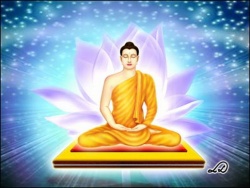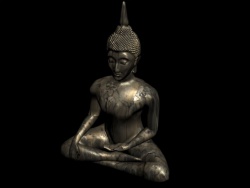Difference between revisions of "Arya"
(Created page with "thumb|250px| Arya (Sanskrit, also ārya; Pāli: ariya) is a term frequently used in Buddhism that can be translated as "noble", "not ordinary", "valuble", "p...") |
|||
| (16 intermediate revisions by 4 users not shown) | |||
| Line 1: | Line 1: | ||
| − | [[File:00-4.jpg|thumb|250px|]] | + | [[File:00-4.jpg|thumb|250px|]]{{DisplayImages|1330|3796|2118}} |
| − | Arya (Sanskrit, also ārya; Pāli: | + | '''[[Arya]]''' (Skt. ''[[ārya]]''; Tib. {{BigTibetan|[[འཕགས་པ་]]}}, ''[[pakpa]]''; [[Wyl.]] '' '[[phags pa]]'') literally means '[[noble]]' or '[[sublime]]'. The [[Tibetan]] [[word]] for [[Arya]] (''[[pakpa]]'') means 'elevated' or '[[exalted]]', and refers to the [[exalted]] [[state]], surpassing that of an ordinary, [[samsaric]] being, which is [[attained]] when reaching the [[path of seeing]], whether as a [[shravaka]], [[pratyekabuddha]] or [[bodhisattva]]. |
| + | |||
| + | ==Subdivisions== | ||
| + | |||
| + | There are [[four classes of noble beings]]: | ||
| + | |||
| + | |||
| + | *[[arhats]] | ||
| + | *[[pratyekabuddhas]] | ||
| + | *[[bodhisattvas]] | ||
| + | *[[buddhas]] | ||
| + | |||
| + | |||
| + | ==Alternative Translations== | ||
| + | |||
| + | *[[Spiritually advanced being]] | ||
| + | {{RigpaWiki}} | ||
| + | |||
| + | {{NewSourceBreak}} | ||
| + | |||
| + | '''[[Arya]]''' ([[Sanskrit]], also [[ārya]]; [[Pāli]]: [[Ariya]]) is a term frequently used in [[Buddhism]] that can be translated as "[[Noble]]", "not ordinary", "valuble", "[[precious]]", "[[pure]]", etc.'''[[Arya]]''' in the [[sense]] "[[Noble]]" or "[[exalted]]" is frequently used in [[Buddhist texts]] to designate a [[spiritual]] [[warrior]] or [[hero]]. | ||
| + | |||
The term is used in the following contexts: | The term is used in the following contexts: | ||
| − | |||
| − | |||
| − | |||
| − | |||
| − | |||
| − | |||
| − | In the context of | + | * The [[Four Noble Truths]] are called the [[catvāry ārya satyāni]] ([[Sanskrit]]) or [[cattāri Ariya saccāni]] ([[Pali]]). |
| + | * The [[Noble Eightfold Path]] is called the [[ārya mārga]] ([[Sanskrit]], also [[āryāṣṭāṅgikamārga]]) or [[Ariya Magga]] ([[Pāli]]). | ||
| + | * [[Buddha]]'[[s]] [[Dharma]] and [[Vinaya]] are the [[ariyassa dhammavinayo]]. | ||
| + | * In [[Buddhist texts]], the [[āryas]] are those who have the [[Buddhist]] [[śīla]] ([[Pāli]] [[Sīla]], meaning "[[Virtue]]") and follow the [[Buddhist path]]. | ||
| + | * [[Buddhists]] themselves are called [[Ariya puggalas]] ([[Arya]] persons). | ||
| + | * Those who despise [[Buddhism]] are often called "[[anāryas]]". | ||
| + | |||
| + | |||
| + | In the context of The [[Four Noble Truths]] ([[Sanskrit]]: [[arya satya]]; [[Pali]]: [[Ariya Sacca]]), contemporary [[scholars]] explain the meaning of [[arya]] as follows: | ||
| + | |||
| + | * [[Paul Williams]] states: "The [[Aryas]] are the [[Noble]] ones, the [[saints]], those who have [[attained]] 'the {{Wiki|fruits}} of the [[path]]', 'that [[middle path]] the [[Tathagata]] has comprehended which promotes [[sight]] and [[Knowledge]], and which tends to [[peace]], [[higher Wisdom]], [[Enlightenment]], and [[Nibbana]]' ([[Narada]] 1980: 50). | ||
| + | |||
| + | * [[Geshe]] [[Tashi Tsering]] states: "The modifier [[Noble]] [i.e. [[arya]] means [[Truth]] as [[perceived]] by [[arya beings]], those [[beings]] who have had a direct [[realization]] of [[Emptiness]] or [[selflessness]]. | ||
| + | |||
| + | [[Noble]] means something seen by [[arya beings]] as it really is, and in this case it is four recognitions—[[Suffering]], origin, [[cessation]], and [[path]]. | ||
| + | |||
| + | [[Arya]] [[beings]] see all types of [[Suffering]]—[[physical]] and [[Mental]], gross and subtle—exactly as they are, as [[Suffering]]. | ||
| + | |||
| + | For [[people]] like us, who do not have the direct [[realization]] of [[Emptiness]], although we may understand certain levels of [[physical]] and [[Mental]] [[experiences]] as [[Suffering]], it is impossible for us to see all the levels of [[Suffering]] for what they are. Instead we may see some things as desirable when in [[Truth]] they are [[Suffering]]." | ||
| + | |||
| + | In [[Buddhism]], those who [[spiritually]] attain to at least "[[stream entry]]" and better are considered [[Arya Pudgala]], or the [[Arya people]]. | ||
| + | |||
| + | In {{Wiki|Chinese}} [[Buddhist texts]], [[ārya]] is translated as [[聖]] (approximately, "{{Wiki|holy}}, [[sacred]]", pinyin [[shèng]], [[on'yomi sei]]). | ||
| + | |||
| + | The [[spiritual]] [[character]] of the use of the term [[ārya]] in [[Buddhist texts]] can also be seen in the [[Mahavibhasa]] and in the [[Yogacarabhumi]]. | ||
| + | |||
| + | The [[Mahāvibhasa]] states that only the [[Noble ones]] ([[āryas]]) realize all four of The [[Four Noble Truths]] ([[āryasatyāni]]) and that only a [[Noble Wisdom]] [[understands]] them fully. | ||
| + | |||
| + | The same text also describes the [[āryas]] as the ones who "have understood and [[realized]] about the [[truth]] of] [[Suffering]], ([[Impermanence]], [[Emptiness]], and [[no-self]])" and who "understand things as they are". In another text, the [[Yogācārabhūmi]] ([[Taishō]] 1579, vol. xx, 364b10-15), the [[āryas]] are described as [[being]] free from the [[viparyāsas]]. | ||
| + | |||
| + | Several [[Buddhist texts]] show that the [[ārya]] [[Dharma]] was [[taught]] to everybody, [[including]] the [[āryas]], [[Dasyus]], [[Devas]], [[Gandharvas]] and [[Asuras]]. | ||
| − | + | The [[Bhaiṣajyavastu]] (from the [[Mūlasarvāstivādavinaya]]) describes a story of [[Buddha teaching]] his [[Dharma]] to the [[Four Heavenly Kings]] ([[Catvāraḥ Mahārājāḥ]]) of the four [[directions]]. | |
| − | + | In this story, the [[guardians of the east]] ([[Dhṛtarāṣṭra]]) and the [[south]] ([[Virūḍhaka]]) are [[āryajatiya]] ([[āryas]]) who speak [[Sanskrit]], | |
| − | + | while the guardians of the [[west]] ([[Virūpākṣa]]) and the [[north]] ([[Vaiśravaṇa]]) are [[dasyujatiya]] ([[Dasyus]]) who speak [[Dasyu languages]]. | |
| − | In | + | In [[order]] to teach his [[Dharma]], [[Buddha]] has to deliver his {{Wiki|discourse}} in [[Aryan]] and [[Dasyu languages]]. |
| − | + | This story describes [[Buddha]] [[teaching]] his [[Dharma]] to the [[āryas]] and [[Dasyus]] alike. | |
| − | + | The [[Karaṇḍavyūha]] (a [[Mahāyāna Sūtra]]) describes how [[Avalokiteśvara]] [[taught]] the [[ārya Dharma]] to the [[Asuras]], [[yakṣas]] and [[rakṣasas]]. | |
| − | In many parts of the South India, if somebody (new) is supposed to be addressed respectably, the prefix "Ayya", derived from "Arya" is used. South Indians used to call them "Arya" which is now transformed to "Ayya". This term is used even today. | + | In many parts of the {{Wiki|South India}}, if somebody (new) is supposed to be addressed respectably, the prefix "[[Ayya]]", derived from "[[Arya]]" is used. [[South]] {{Wiki|Indians}} used to call them "[[Arya]]" which is now [[transformed]] to "[[Ayya]]". This term is used even today. |
{{R}} | {{R}} | ||
[[Wikipedia:Arya (Buddhism)]] | [[Wikipedia:Arya (Buddhism)]] | ||
| + | {{PaliTerminology}} | ||
[[Category:Buddhist philosophical concepts]] | [[Category:Buddhist philosophical concepts]] | ||
| − | |||
Latest revision as of 04:13, 11 March 2016
Arya (Skt. ārya; Tib. འཕགས་པ་, pakpa; Wyl. 'phags pa) literally means 'noble' or 'sublime'. The Tibetan word for Arya (pakpa) means 'elevated' or 'exalted', and refers to the exalted state, surpassing that of an ordinary, samsaric being, which is attained when reaching the path of seeing, whether as a shravaka, pratyekabuddha or bodhisattva.
Subdivisions
There are four classes of noble beings:
Alternative Translations
Source
Arya (Sanskrit, also ārya; Pāli: Ariya) is a term frequently used in Buddhism that can be translated as "Noble", "not ordinary", "valuble", "precious", "pure", etc.Arya in the sense "Noble" or "exalted" is frequently used in Buddhist texts to designate a spiritual warrior or hero.
The term is used in the following contexts:
- The Four Noble Truths are called the catvāry ārya satyāni (Sanskrit) or cattāri Ariya saccāni (Pali).
- The Noble Eightfold Path is called the ārya mārga (Sanskrit, also āryāṣṭāṅgikamārga) or Ariya Magga (Pāli).
- Buddha's Dharma and Vinaya are the ariyassa dhammavinayo.
- In Buddhist texts, the āryas are those who have the Buddhist śīla (Pāli Sīla, meaning "Virtue") and follow the Buddhist path.
- Buddhists themselves are called Ariya puggalas (Arya persons).
- Those who despise Buddhism are often called "anāryas".
In the context of The Four Noble Truths (Sanskrit: arya satya; Pali: Ariya Sacca), contemporary scholars explain the meaning of arya as follows:
- Paul Williams states: "The Aryas are the Noble ones, the saints, those who have attained 'the fruits of the path', 'that middle path the Tathagata has comprehended which promotes sight and Knowledge, and which tends to peace, higher Wisdom, Enlightenment, and Nibbana' (Narada 1980: 50).
- Geshe Tashi Tsering states: "The modifier Noble [i.e. arya means Truth as perceived by arya beings, those beings who have had a direct realization of Emptiness or selflessness.
Noble means something seen by arya beings as it really is, and in this case it is four recognitions—Suffering, origin, cessation, and path.
Arya beings see all types of Suffering—physical and Mental, gross and subtle—exactly as they are, as Suffering.
For people like us, who do not have the direct realization of Emptiness, although we may understand certain levels of physical and Mental experiences as Suffering, it is impossible for us to see all the levels of Suffering for what they are. Instead we may see some things as desirable when in Truth they are Suffering."
In Buddhism, those who spiritually attain to at least "stream entry" and better are considered Arya Pudgala, or the Arya people.
In Chinese Buddhist texts, ārya is translated as 聖 (approximately, "holy, sacred", pinyin shèng, on'yomi sei).
The spiritual character of the use of the term ārya in Buddhist texts can also be seen in the Mahavibhasa and in the Yogacarabhumi.
The Mahāvibhasa states that only the Noble ones (āryas) realize all four of The Four Noble Truths (āryasatyāni) and that only a Noble Wisdom understands them fully.
The same text also describes the āryas as the ones who "have understood and realized about the truth of] Suffering, (Impermanence, Emptiness, and no-self)" and who "understand things as they are". In another text, the Yogācārabhūmi (Taishō 1579, vol. xx, 364b10-15), the āryas are described as being free from the viparyāsas.
Several Buddhist texts show that the ārya Dharma was taught to everybody, including the āryas, Dasyus, Devas, Gandharvas and Asuras.
The Bhaiṣajyavastu (from the Mūlasarvāstivādavinaya) describes a story of Buddha teaching his Dharma to the Four Heavenly Kings (Catvāraḥ Mahārājāḥ) of the four directions.
In this story, the guardians of the east (Dhṛtarāṣṭra) and the south (Virūḍhaka) are āryajatiya (āryas) who speak Sanskrit,
while the guardians of the west (Virūpākṣa) and the north (Vaiśravaṇa) are dasyujatiya (Dasyus) who speak Dasyu languages.
In order to teach his Dharma, Buddha has to deliver his discourse in Aryan and Dasyu languages.
This story describes Buddha teaching his Dharma to the āryas and Dasyus alike.
The Karaṇḍavyūha (a Mahāyāna Sūtra) describes how Avalokiteśvara taught the ārya Dharma to the Asuras, yakṣas and rakṣasas.
In many parts of the South India, if somebody (new) is supposed to be addressed respectably, the prefix "Ayya", derived from "Arya" is used. South Indians used to call them "Arya" which is now transformed to "Ayya". This term is used even today.



